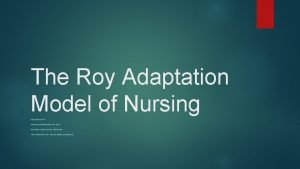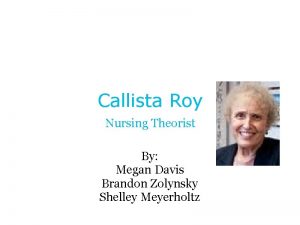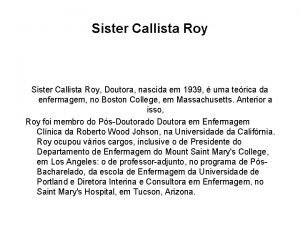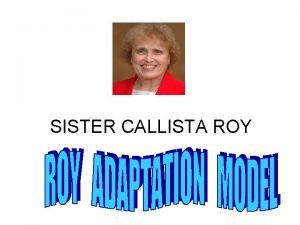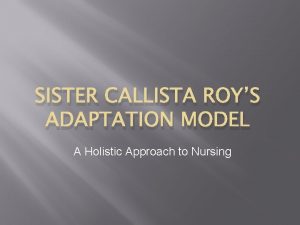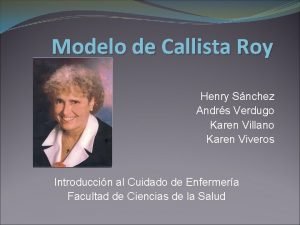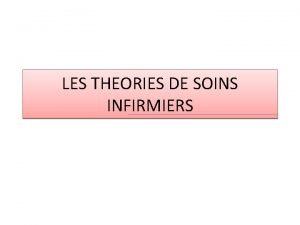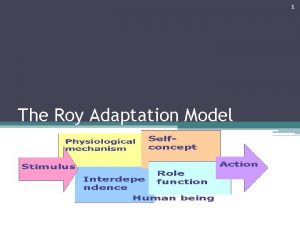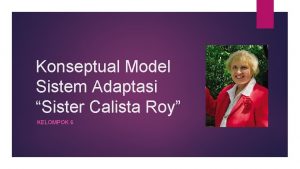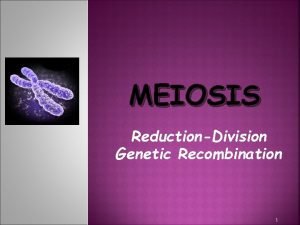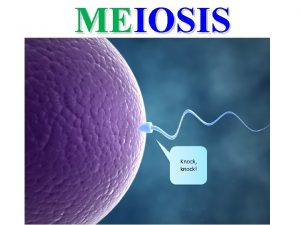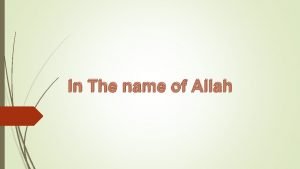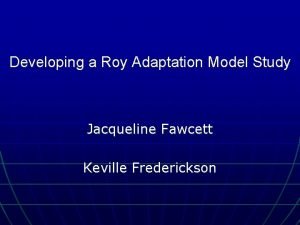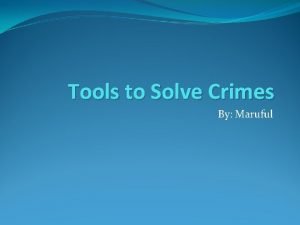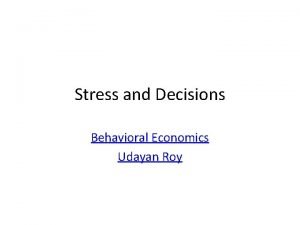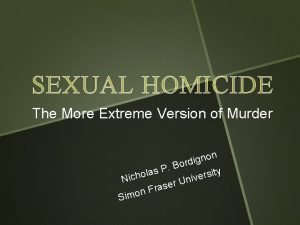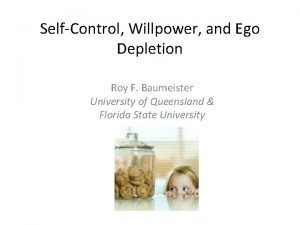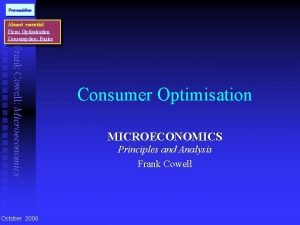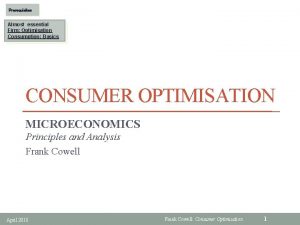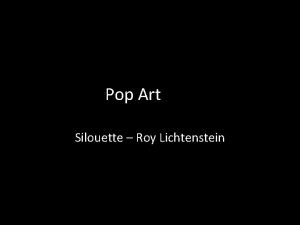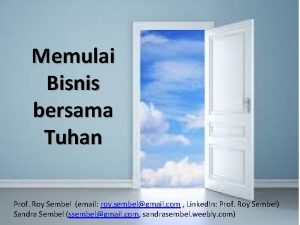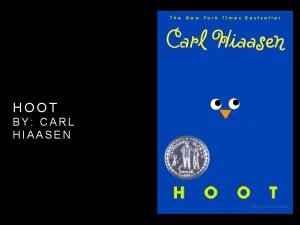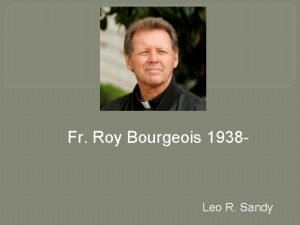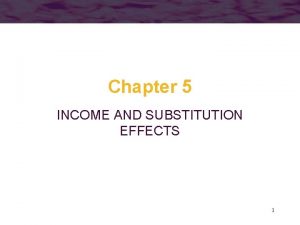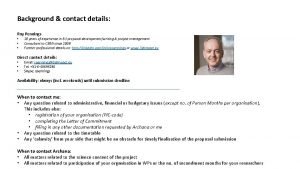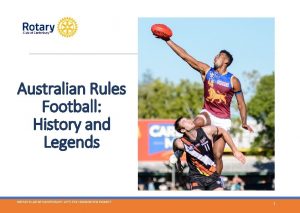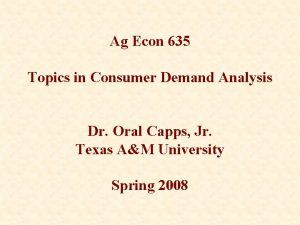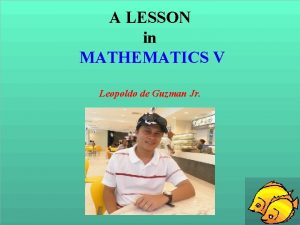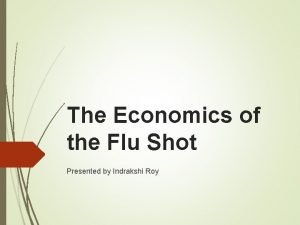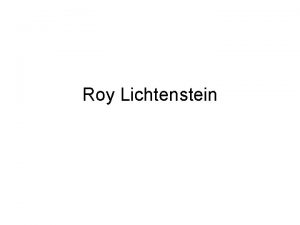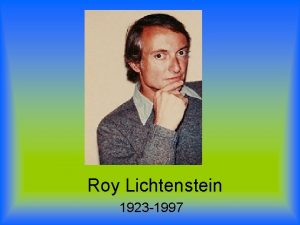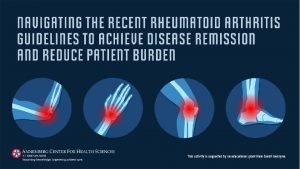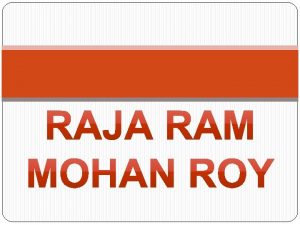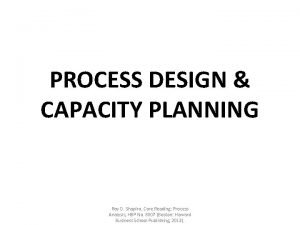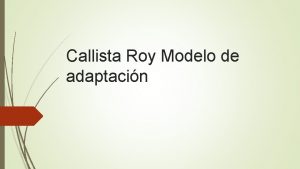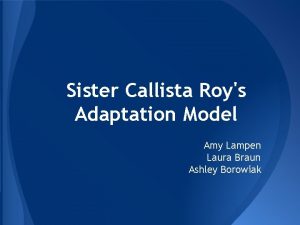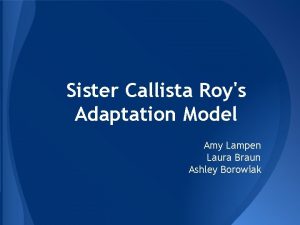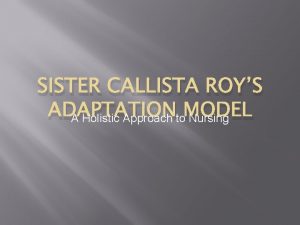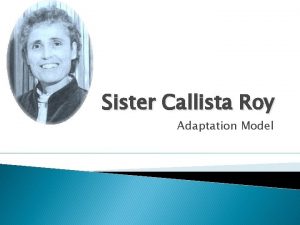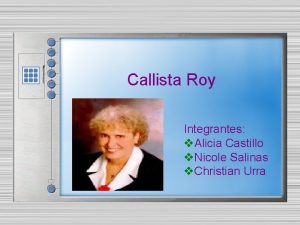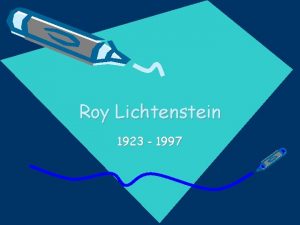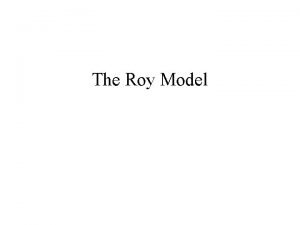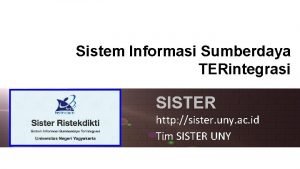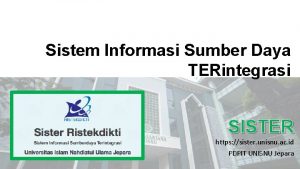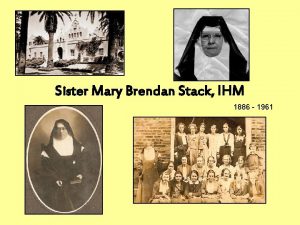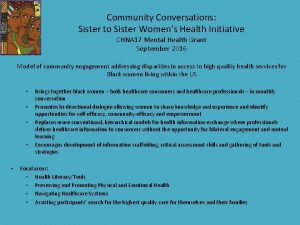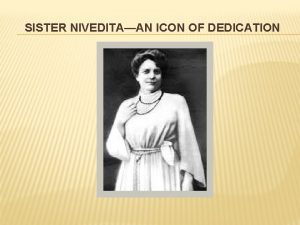SISTER CALLISTA ROY HISTORY OF ROYS MODEL FIRST

















































- Slides: 49

SISTER CALLISTA ROY

HISTORY OF ROY’S MODEL • FIRST DESCRIPTIONS OF MODEL – Personal and professional background – Philosophical beliefs

FIRST PUBLISHED • 1970 published in “Nursing Outlook” • 1999

FACULTY OF COLLEGE • 1500 faculty and students

ADAPTATION • “A PROCESS OF RESPONDING POSITIVELY TO ENVIRONMENTAL CHANGES”

ADAPTATION LEVELS • - Constantly changing stimuli Focal Contextual Residual

COPING MECHANISMS • INNATE (AUTOMATIC) • ACQUIRED (LEARNED)

METAPARADIGMS OF MODEL • - Person Individual nursing vs group nursing Coping mechanism Behaviors – adaptive modes

METAPARADIGMS OF MODEL • Environment - world within and around the person - 3 classes of stimuli

METAPARADIGMS OF MODEL • Health

METAPARADIGMS OF MODEL • Nursing -science and application of knowledge -nursing process

• - CONCEPTS UNIQUE TO THE MODEL Holistic adaptive system 3 types of stimuli Adaptation levels Coping mechanisms

THREE TYPES OF STIMULI • Focal Stimuli- internal or external stimuli that most immediately confront the human system • Contextual stimuli – all other stimuli that contribute to the effect of the focal stimuli • Residual stimuli – environmental stimuli within or without the human system with effects in the current situation that are unclear

ADAPTATION LEVEL • Life processes – described in 3 levels - integrated - compensatory - compromised • Adaptation levels- “a constantly changing point, made up of focal, contextual and residual stimuli, which represent one’s own standard of the range of stimuli to which one can respond with ordinary adaptive responses”

COPING MECHANISMS • • Innate coping mechanisms Acquired coping mechanisms Regulator subsystem Cognator subsystem

ROLE FUNCTION MODE 3 ROLES • Primary – determined by age, sex, and developmental stage, determines majority of behaviors • secondary - normally achieved positions, assumed to complete developmental tasks • tertiary roles – role associated obligations, freely chosen, temporary in nature

COMPONETS • Each role has instrumental components – going to work, doing housework, assisting with child care • and expressive components – sending a gift, hugging children, complaining about boss

CLINICAL PRACTICE - Utilization - Nurses’ role

SUBSYSTEMS • Persons as a whole are made up of 6 subsystems which respond either through innate (natural) or acquired (learned) responses. • 2 coping systems which are the cognator and regulator, the cognator being the psychological mechanism and the regulator being the physiological mechanism and the 4 adaptive modes

CLINICAL PRACTICE • Assess behaviors manifested from 4 adaptive modes -physiological -self-concept -role function -interdependence

ROY’S DEFINITION OF HEALTH • “HEALTH IS THE PROCESS OF BEING AND BECOMING AN INTEGRATED AND WHOLE PERSON”

STIMULI • Focal – most immediate • Contextual – not center of attention or energy of patient, all other stimuli • Residual – “environmental factors within or without the human system with effects in the current situation that are unclear”

PATIENT ASSESSMENT • • • Nursing diagnosis Goal setting Intervention Evaluation Detailed patient history

NURSING PROCESS FRAMEWORK FOR PATIENT ASSESSMENT • Assesses the behaviors manifested from the four adaptive modes • Assesses the stimuli for those behaviors and categorizes them as focal, contextual, or residual stimuli • Make a statement or a nursing diagnosis of the person’s adaptive state

NURSING PROCESS CONTINUED • Sets goals to promote adaptation • Implements interventions aimed at managing the stimuli to promote adaptation • Evaluates whether the adaptive goals have been met

MODEL WITHIN CONTEXT OF NURSING EDUCATION * Teaches the student to promote adaptation of the patient in each of the 4 adaptive modes. Physiological (Physical responses) Self concept (Thoughts & beliefs) Interdependence Relations with people (Love, respect, value) Role function (behavior in society)

Nursing student focus • To help patient put energies into getting well.

Theory development for students I have a Theory idea

Teaching Students to Care for Patients

Research of the Model • • Review of research is ongoing Practice Theory development Evaluation of research instruments to measure key concepts.

Example of Research Instrument • STRESS – Stress – Touch interventions – Reduction of pain – Environmental considerations – State – Stability

Development of Model r/t spirituality and global consideration

Development of middle range theories • Example – Dunn (2004) Chronic pain • Findings were manifestations of adaptation to chronic pain are its effects on functional ability and psychological and spiritual well-being.

STRENGTHS OF MODEL • Arrangement of concepts -Adaptation – goal of nursing -Person – adaptive system -Environment – stimuli -Health – outcome of adaptation -Nursing – promoting adaptation and health

STRENGTHS • Clearly defined nursing process • Useful in guiding clinical practice • Accommodates for physical as well as psychosocial needs • Encourages professionalism is nursing by the use of complete nursing diagnosis related care plan

STRENGTHS • Patient plays an active role – nurse is a guide • Persons values and opinions are considered and respected

STRENGTHS • Easy to use in out patient settings

Roy Model Applications • Smoking cessation group • Women with breast cancer • Caregivers with chronically ill family members • Persons with chronic renal failure • Community health nursing

LIMITATIONS • • • Assumptions – 4 adaptive modes Holistic view Condition-response based Person as an adaptive system No direction for priority setting

LIMITATIONS • Difficult to use where rapid change occurs

CASE STUDY Primary role 32 year old young adult male teacher husband father Laundry 2 x week Fix dinner 2 x week colleague Secondary roles Cub scout leader Tertiary roles Roles in the Roy adaptation model coach student

NURSING ASSESSMENT • • • Abdominal pain Angry outbursts Elevated liver enzymes Nausea and vomiting Low level of self esteem Inter-actional skills

NURSING DIAGNOSIS • • Adaptive and ineffective behaviors Focal stimuli - alcohol Contextual stimuli - stress Residual - family history

GOAL SETTING • - Behavior outcomes Attend AA meeting Counseling for anger management Medication regime No alcohol No angry outbursts

INTERVENTION • Taking prescribed meds to help with anxiety and withdrawal symptoms • Exercise regime • Positive family interaction as evidenced by increased family time – meals with family, playing with children • Assigning a sponsor for AA class

EVALUATION • Degree of change as evidenced by change in behavior - Has attended AA meetings for five weeks - Participating with a counselor for anger issues - Taking family walks five nights per week - Remains sober - Taking meds as prescribed

ANALYSIS • Outcome theory based

ANALYSIS • • Science and art of nursing Holistic needs Testing of hypothesis Most frequently used model to guide nursing • Model is taught as part of curriculum of most baccalaureate, master, and doctoral programs of nursing • Inspires many middle range nursing theories

REFERENCES • Roy, Sister Callista. (1984). Introduction to Nursing: An Adaptation Model. Englewood Cliffs, NJ: Prentice-Hall, Inc. • Andrews, Heather A. , Roy, Sister Callista. (1986). Essentials of the Roy Adaptation Model. Norwalk, CT: Appleton-Century-Crofts. • Alligood, Martha Raile, Tomey, Ann Marriner. (1998). Nursing Theorists and Their Work. St. Louis, MO: Mosby – Yearbook, Inc. • The Roy’s adaptation Model. Current Nursing. Obtained on 12/1/08 from website http: //currentnursing. com/nursing_theory/Roy_adaptation. • WEB SITE IMAGES obtained from following sites: -bc. edu -nursingtheories. blogspot. com -barnesandnoble. com -pearsonhighered. com -sariprena. blogspot. com -turbosquid. com
 Callista roy biographie
Callista roy biographie Sister callista roy theory
Sister callista roy theory Teoria da adaptação callista roy slide
Teoria da adaptação callista roy slide Regulator subsystem example
Regulator subsystem example Sister callista roy nursing theory
Sister callista roy nursing theory Biografia callista roy
Biografia callista roy Callista roy théorie
Callista roy théorie Callista roy biographie
Callista roy biographie Kognator
Kognator Homologous and non homologous chromosome
Homologous and non homologous chromosome Sister and non sister chromatids
Sister and non sister chromatids Roy adaptacijski model
Roy adaptacijski model Aqeedah roy
Aqeedah roy Roy adaptation model diagram
Roy adaptation model diagram Romit roy choudhury
Romit roy choudhury Roy kenshin lee
Roy kenshin lee The zulu girl roy campbell
The zulu girl roy campbell Hubbart formula
Hubbart formula Udayan roy
Udayan roy Still life with goldfish
Still life with goldfish Bittaker and norris polaroids
Bittaker and norris polaroids Roy baumeister ego depletion
Roy baumeister ego depletion Roy sharples
Roy sharples Roy g bv
Roy g bv Optimisation
Optimisation Shephard's lemma
Shephard's lemma Roy lichtenstein presentation
Roy lichtenstein presentation Pop art self portrait
Pop art self portrait Prof roy sembel
Prof roy sembel Flocaublary
Flocaublary Roy in hoot
Roy in hoot Fr roy bourgeois
Fr roy bourgeois Roy schulte
Roy schulte Income effect formula
Income effect formula Laurie pennings
Laurie pennings Bill hutchinson afl
Bill hutchinson afl Roy's identity
Roy's identity Roy planted a vegetable garden in his backyard
Roy planted a vegetable garden in his backyard Roy fieldings
Roy fieldings Indrakshi roy
Indrakshi roy When was roy lichtenstein born
When was roy lichtenstein born Ben day dots stencil
Ben day dots stencil Roy fleischmann
Roy fleischmann Rrrlf in library science
Rrrlf in library science Raja ram mohan roy conclusion
Raja ram mohan roy conclusion Roy d. shapiro
Roy d. shapiro Roy lichtenstein indians pursued by american dragoons
Roy lichtenstein indians pursued by american dragoons Kaushik roy ncat
Kaushik roy ncat Drive reduction theory
Drive reduction theory Judge roy moore poem
Judge roy moore poem
